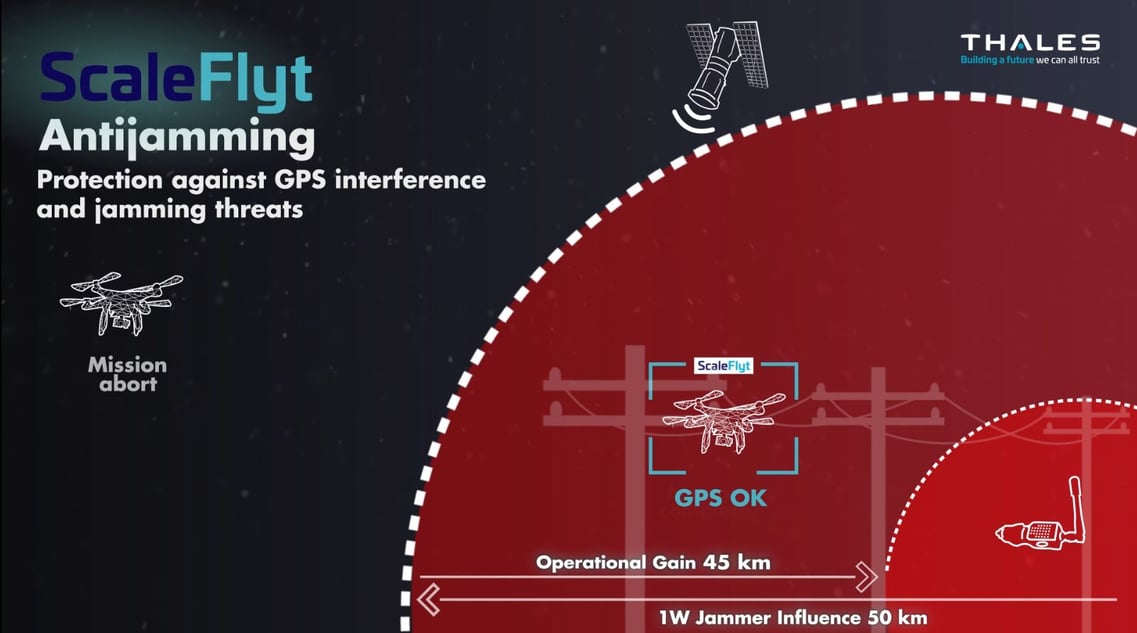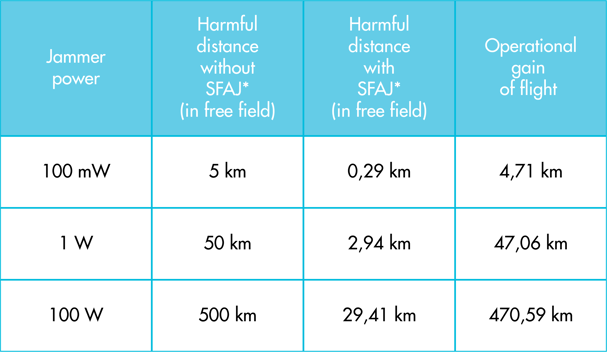Drones, flying hundreds of meters in the air, allow for rapid and efficient aerial data acquisition with increasingly powerful sensors. However, uncontrolled risks associated with the drone's flight environment can have irreversible consequences on its mission, such as loss of control of the system, flyaway, or even the drone's fall.

Among the most significant threats that you may encounter during your drone operations, jamming is undoubtedly one of the most compromising to the success of your mission. In this article, we discuss the origins and consequences of this type of threat on your drone operations.
One of the biggest threats to the security of drone operations is interference with the GNSS/GPS receiver, which disrupts the reception of satellite signals that the drone needs for autonomous navigation in its airspace. Threats associated with jamming can lead to the loss of GNSS/GPS reception for a drone and can thus reduce the accuracy of the data from the onboard camera, causing the drone to collide with low-altitude obstacles because the operator will no longer benefit from automatic assistance in complex take-off and landing phases, especially when the wind is not favorable.
GNSS satellites, being thousands of kilometers from the Earth (20,000km), have very weak signals compared to deliberate or unintentional jamming signals, which can propagate over shorter distances from the ground and can reach up to ten watts. This vulnerability exposes the drone's GNSS/GPS receiver.
Below are some examples of unintentional sources of interference that can impact drone navigation:
Car cigarette lighter jammers: These jammers are often used to avoid detection of vehicles equipped with GPS tracking systems, such as commercial fleets. They can disrupt GPS signals nearby, including those received by drones, especially when the jammer is used within close proximity to the drone. The impact on drone navigation can be the loss of connection with GPS satellites, which can lead to unstable trajectory and drone drift.
Old satellite dishes: Old satellite dishes can be a source of unintentional interference due to their reflectivity. GPS signals reflected by a dish can disrupt actual GPS signals received by the drone, creating interference and inconsistencies in the drone's positioning data. This can result in loss of precision in drone position and trajectory.
Amateur radio: Radio transmitters used by amateur radio operators can emit electromagnetic signals that can interfere with GPS signals received by drones. These interferences can disrupt GPS signal reception and result in positioning errors for the drone, potentially causing loss of control or stability.
These sources of unintentional interference can be unpredictable and random. Interference caused by these sources can vary in intensity and frequency, making it difficult to prevent their impact on drone navigation.
In addition, intentional sources of interference are equally harmful to your GNSS reception. Here are some intentional sources of interference that can affect your operations:
GPS jammers: GPS jammers are electronic devices that emit radio frequency signals on the same frequency as GPS signals, which can disrupt the reception of GPS signals by the drone.
GPS spoofing: GPS spoofing is a technique in which a fake GPS signal is emitted to trick the drone's GPS receiver into thinking it is at a different location than its actual position. This can disrupt drone navigation and control.
Radio frequency interference: Radio frequency interference can be caused by other electronic devices emitting radio frequency signals, such as telecommunication antennas or radars. These interferences can disrupt GPS signal reception by the drone.
Wave jamming: GPS signals are weak and can be easily disrupted by powerful electromagnetic waves. Devices can be used to emit electromagnetic waves that disrupt GPS signal reception by the drone.
To address this increasingly widespread threat to drone navigation, the most effective and suitable solution is the ScaleFlyt Antijamming. This solution protects the GNSS receiver from interference caused by a jammer. This module is installed directly on the drone near the GNSS receiver.
When conducting a surveillance operation, ScaleFlyt Antijamming reduces the risk of crashing or losing interaction between your drone and the satellite. It optimizes the responsiveness of your operational GNSS receiver during flight by protecting it from various jamming signals. ScaleFlyt Antijamming allows you to classify the intensity of interference into three levels (Low, High, Medium) and reduces the range of interference caused by the jamming source by a factor of 17 .

Using our ScaleFlyt Antijamming solution has the advantage of being agnostic. It is suitable for all types of drones due to its small size and low weight.
ScaleFlyt Antijamming is suitable for all use cases because the issue of interference concerns all actors involved in drone operations. To better illustrate the use of this solution, let's take the example of inspecting a 95km section of a gas network near a highway. Your drone is equipped with ScaleFlyt Antijamming, and you receive an indication of interference intensity (Low, Medium, High) on your ground station. This alert informs you that you are passing through a highly saturated interference zone (High). In fact, the vehicle of a commercial traveling on the highway near your flight zone is equipped with a cigarette lighter jammer. The operation of the ScaleFlyt Antijamming is as follows: the Antijamming will respond by adapting the resulting antenna diagram with a very low gain in the direction of the jamming source, allowing you to maintain the connection between your GNSS receiver and the satellite. ScaleFlyt Antijamming protects against dynamic signals, meaning that the resulting antenna diagram adaptation adjusts based on the jammer's movement.
As a result, the effect of interference is limited and your mission continues as if nothing happened. You reduce risks in the air and on the ground, save time, and avoid potential material or human damage.
Now you know an effective solution to ensure the safety of your drone operations. Safety culture is a major concern within our teams, and we believe that a secure mission greatly increases the chances of its success.